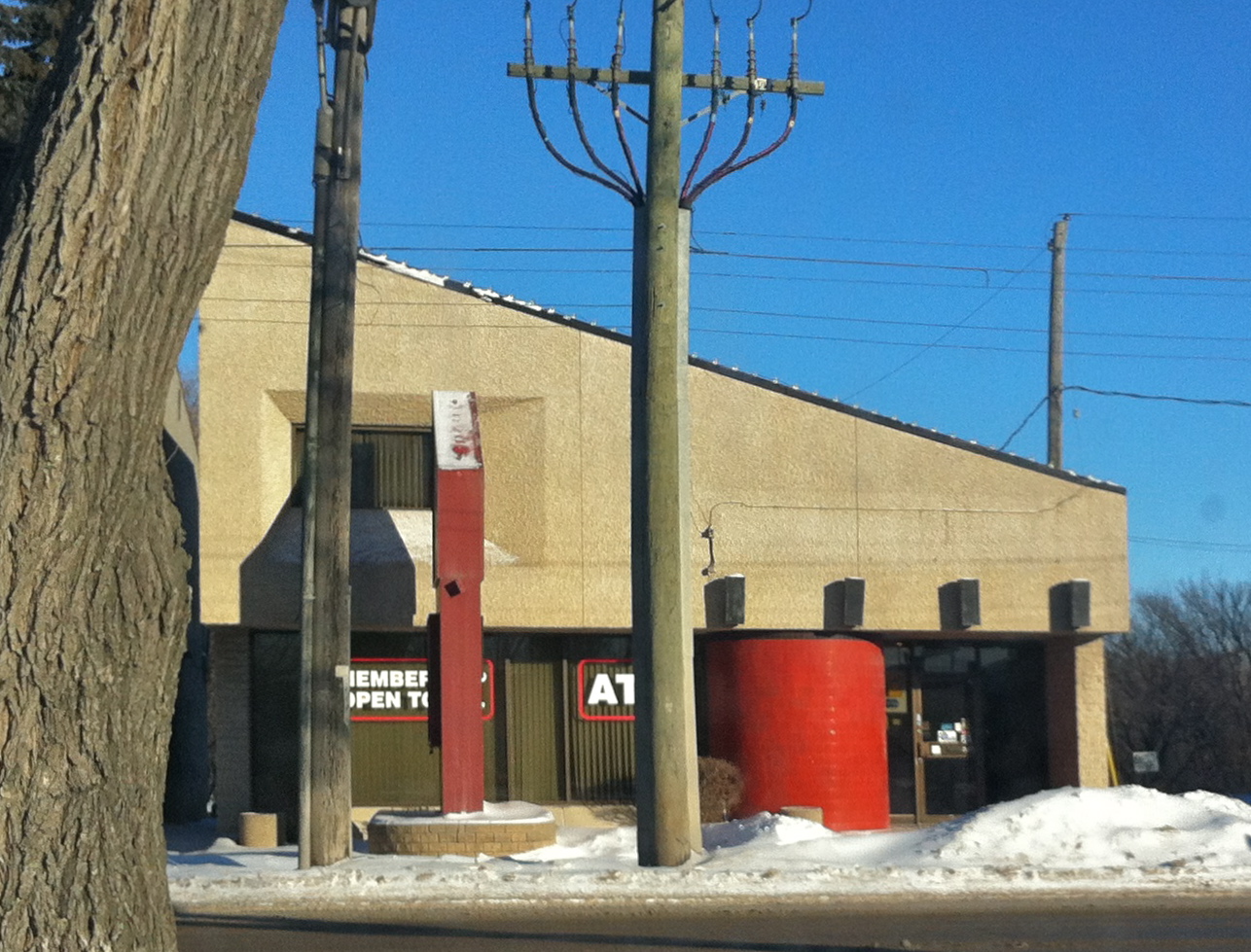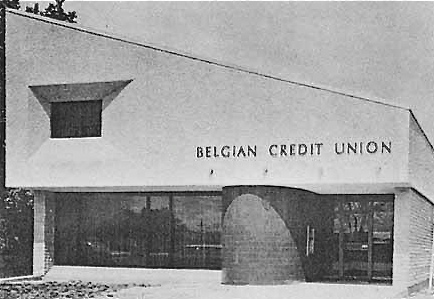Belgian Alliance Credit Union
| Former Names: |
|
|---|---|
| Address: | 387 Provencher Boulevard |
| Constructed: | 1975 |
| Architects: |
More Information
387 Provencher Boulevard was completed in 1975 to house the Belgian Credit Union. Designed by the firm of Pratt Lindgren Snider Tomcej and Associates the building features a mono-pitch roof of the sort popular during this era. It’s late-modern aesthetics extend to the orange tiled semi-circular section that embellishes its lower floor front elevation and its angular inset upper window.
The area housing 387 Provencher Boulevard is long associated with Winnipeg’s Belgian community. The group settled in the area in the nineteenth century. Among the other remaining traces of this history is Le Club Belge, at 407 Provencher Boulevard. Dating to 1906-14 this cultural centre is a two-storey meeting hall clad in brick and Tyndall limestone. In front stands a memorial: a portrayal of a soldier standing over a fallen comrade. This 1938 monument was paid for by the Belgian Veterans Association and made by artist Hubert A. Garnier. South and west of this site, rue Des Meurons had evolved into a vital commercial street frequented by the Belgian community and others. Across the Seine River from Des Meurons stood Sacred Heart, the first Belgian church in Manitoba. Erected by Flemish-speaking settlers, the church was built by F. Wyndels for $9,000, and opened in 1917. Adjacent to Sacred Heart was the “Grotto of Notre Dame de Lourdes.” Situated on the banks of the Seine River, the Grotto opened May 25, 1936 to a crowd of thousands. Built of concrete and stone assembled to recall a natural geological formation, it served as a tourist attraction and a pilgrimage site until its destruction by floodwaters.
Belgian-Canadians from this area would continue to play a role in St. Boniface’s growth in later years with such nearby projects as Place Cabana, a housing co-operative for French-speaking Catholic families initiated by the Archdiocese of St. Boniface in 1952, and built by local contractor Boel.
St. Boniface is the heart of Franco-Manitoban culture, a Western Canadian hub of francophone culture and an important site in the history of the Métis people. It has played an important role in the evolution of the Province of Manitoba. The area around the forks of the Red and Assiniboine Rivers was, for many generations, a site for camping, trading and other activities by Indigenous peoples. In the late eighteenth and early nineteenth centuries land to the west of the Red River hosted a variety of European settlements, including Forts Rouge, Gibraltar and Douglas and the Red River Colony. The roots of the present built form of St. Boniface can be found in these years. In the early nineteenth century the area was settled by groups of Métis fur traders and mercenaries hired to protect the Red River Colony; the latter included the German-Swiss De Meurons regiment.
In 1818 Québécois Father Joseph-Norbert Provencher was sent to Manitoba at the behest of local citizens, the Hudson’s Bay Company and Scottish Lord Selkirk to found the first permanent Roman Catholic post west of the Great Lakes in present-day Canada at St. Boniface. The church was given the title to a large tract of land to the east and south of the forks to aide its efforts. These endeavours led, in 1818, to the construction of the first church in Western Canada, not far from the site of St. Boniface Cathedral. The early development of this district included a school near the 1818 church. These two structures encouraged Catholic colonists to settle east of the Red River. They also set in motion two major themes that would characterise the architecture of the district: religion and academia. To this day St. Boniface is home to a number of Manitoba’s most significant historical structures, many of which relate to this early period and these themes.
Beyond its religious and educational activity, by the early twentieth century St. Boniface developed into an important transportation and industrial centre for Western Canada. Since 1878, facilities for the Canadian Pacific Railway (CPR) were located in the area. Over time St. Boniface would entice all three of the country’s major railways to build locally, with Canadian Northern’s main line and the Grand Trunk Pacific-Transcontinental Railway joining the CPR. St. Boniface capitalised on the presence of the railways to become a major industrial hub, housing iron, steel, lumber, brick and flour mills as well as grain elevators and factories. In addition to industrial growth, the first half of the twentieth century saw St. Boniface develop a new commercial and civic heart, with Provencher Boulevard as its nucleus.
During the middle of the twentieth century, modern architecture found a home across St. Boniface. No firm or architect is as associated with modern architecture in St. Boniface as Étienne Gaboury. Indeed, few architects anywhere possess a body of work so closely associated with one community. Among Gaboury’s works in St. Boniface are the 1963 St. Boniface Clinic, the 1964 St. Boniface Civic Centre, the 1969 Église du Précieux Sang, the reconstruction of St. Boniface Cathedral (from 1970) and the 1974 Centre culturel Franco-manitobain. Over the following decades, construction of many projects of Brutalist and late-modern character took place in St. Boniface. These included small commercial structures on Provencher Boulevard and rue Marion.
In 2003 the area gained a new iconic structure, a dramatic cable-stayed footbridge over the Red River, known as Esplanade Riel. The bridge is in line with Provencher Boulevard, and is uncommon for housing at its centre an enclosed space – a cantilevered space that houses a seasonal restaurant. The bridge is in many ways the culmination of the earlier vision of its architect, Gaboury.
During the twenty-first century St. Boniface has experienced increasing architectural growth, particularly manifested in the development of multi-tenant residential properties and creative additions to St. Boniface Hospital, Université de Saint-Boniface and Centre culturel Franco-manitobain. These projects and others have remade the area through post-modern, neo-modern and hybrid approaches. St. Boniface continues to possess a character distinct in Winnipeg, continuing of a long legacy of uniqueness that dates back centuries.
Design Characteristics
| Materials: | stucco |
|---|---|
| Neighbourhood: | St. Boniface |
- Orange tiled semi-circular section
- Mono-pitch roof
- Triangular facade
- Stucco cladding
- Glazed main floor front elevation
- Inset window with angular design

